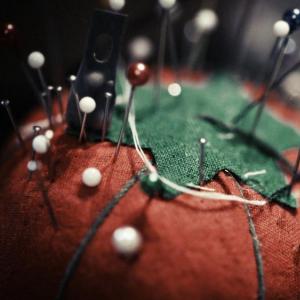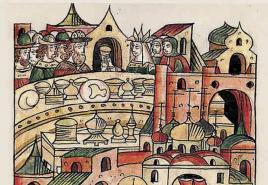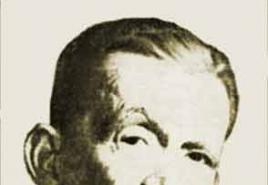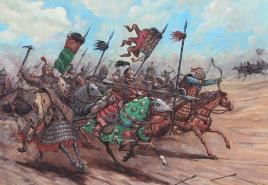At the first stage of cellular respiration. Successive stages of aerobic respiration in a cell. β-oxidation of fatty acids
Cellular respiration- This is the oxidation of organic substances in the cell, as a result of which ATP molecules are synthesized. The starting raw materials (substrate) are usually carbohydrates, less often fats and even less often proteins. The largest number of ATP molecules is produced by oxidation with oxygen, the smaller number is produced by oxidation by other substances and electron transfer.
Carbohydrates, or polysaccharides, are broken down into monosaccharides before being used as a substrate for cellular respiration. So in plants, starch, and in animals, glycogen is hydrolyzed to glucose.
Glucose is the main source of energy for almost all cells of living organisms.
The first stage of glucose oxidation is glycolysis. It does not require oxygen and is characteristic of both anaerobic and aerobic respiration.
Biological oxidation
Cellular respiration involves a variety of redox reactions in which hydrogen and electrons move from one compound (or atom) to another. When an atom loses an electron, it oxidizes; when an electron is added - reduction. The oxidized substance is a donor, and the reduced substance is an acceptor of hydrogen and electrons. Redox reactions occurring in living organisms are called biological oxidation, or cellular respiration.
Typically, oxidative reactions release energy. The reason for this lies in physical laws. Electrons in oxidized organic molecules are at a higher energy level than in the reaction products. Electrons, moving from a higher to a lower energy level, release energy. The cell knows how to fix it in the bonds of molecules - the universal “fuel” of living things.
The most common terminal electron acceptor in nature is oxygen, which is reduced. During aerobic respiration, carbon dioxide and water are formed as a result of the complete oxidation of organic substances.
Biological oxidation occurs in stages, involving many enzymes and electron-transferring compounds. In stepwise oxidation, electrons move along a chain of carriers. At certain stages of the chain, a portion of energy is released sufficient for the synthesis of ATP from ADP and phosphoric acid.
Biological oxidation is very effective compared to various engines. About half of the released energy is ultimately fixed in high-energy bonds of ATP. The other part of the energy is dissipated as heat. Since the oxidation process is stepwise, then thermal energy is released little by little and does not damage cells. At the same time, it serves to maintain a constant body temperature.
Aerobic respiration
Different stages of cellular respiration occur in aerobic eukaryotes
in the mitochondrial matrix -, or the tricarboxylic acid cycle,
on the inner membrane of mitochondria - or the respiratory chain.
At each of these stages, ATP is synthesized from ADP, most of all at the last. Oxygen is used as an oxidizing agent only at the stage of oxidative phosphorylation.
The total reactions of aerobic respiration are as follows.
Glycolysis and the Krebs cycle: C 6 H 12 O 6 + 6H 2 O → 6CO 2 + 12H 2 + 4ATP
Respiratory chain: 12H 2 + 6O 2 → 12H 2 O + 34ATP
Thus, the biological oxidation of one glucose molecule produces 38 ATP molecules. In fact, it is often less.
Anaerobic respiration
During anaerobic respiration in oxidative reactions, the hydrogen acceptor NAD does not ultimately transfer hydrogen to oxygen, which is not present in this case.
Pyruvic acid, formed during glycolysis, can be used as a hydrogen acceptor.
In yeast, pyruvate is fermented to ethanol (alcoholic fermentation). In this case, during the reactions, carbon dioxide is also formed and NAD is used:
CH 3 COCOOH (pyruvate) → CH 3 CHO (acetaldehyde) + CO 2
CH 3 CHO + NAD H 2 → CH 3 CH 2 OH (ethanol) + NAD
Lactic acid fermentation occurs in animal cells experiencing a temporary lack of oxygen, and in a number of bacteria:
CH 3 COCOOH + NAD H 2 → CH 3 CHOHCOOH (lactic acid) + NAD
Both fermentations do not produce ATP. Energy in this case is provided only by glycolysis, and it amounts to only two ATP molecules. Much of the energy from glucose is never recovered. Therefore, anaerobic respiration is considered ineffective.
Energy exchange- this is a stage-by-stage decomposition of complex organic compounds, occurring with the release of energy, which is stored in the high-energy bonds of ATP molecules and is then used in the process of cell life, including for biosynthesis, i.e. plastic exchange.
In aerobic organisms there are:
- Preparatory- splitting of biopolymers into monomers.
- Oxygen-free- glycolysis - the breakdown of glucose into pyruvic acid.
- Oxygen- breakdown of pyruvic acid to carbon dioxide and water.
Preparatory stage
At the preparatory stage of energy metabolism, the breakdown of organic compounds supplied with food into simpler ones, usually monomers, occurs. This is how carbohydrates are broken down into sugars, including glucose; proteins - to amino acids; fats - to glycerol and fatty acids.
Although energy is released, it is not stored in ATP and therefore cannot be used later. Energy is dissipated as heat.
The breakdown of polymers in multicellular complex animals occurs in digestive tract under the influence of enzymes secreted here by the glands. The resulting monomers are then absorbed into the blood mainly through the intestines. The blood carries nutrients throughout the cells.
However, not all substances decompose into monomers in the digestive system. The breakdown of many occurs directly in cells, in their lysosomes. In single-celled organisms, absorbed substances enter the digestive vacuoles, where they are digested.
The resulting monomers can be used for both energy and plastic exchange. In the first case, they are broken down, in the second, the components of the cells themselves are synthesized from them.
Oxygen-free stage of energy metabolism
The oxygen-free stage occurs in the cytoplasm of cells and, in the case of aerobic organisms, includes only glycolysis - enzymatic multi-stage oxidation of glucose and its breakdown to pyruvic acid, which is also called pyruvate.
The glucose molecule contains six carbon atoms. During glycolysis, it is broken down into two molecules of pyruvate, which contains three carbon atoms. In this case, part of the hydrogen atoms is split off, which are transferred to the coenzyme NAD, which, in turn, will then participate in the oxygen stage.
Part of the energy released during glycolysis is stored in ATP molecules. For one molecule of glucose, only two molecules of ATP are synthesized.
The energy remaining in pyruvate, stored in NAD, in aerobes will be further extracted in the next stage of energy metabolism.
Under anaerobic conditions, when the oxygen stage of cellular respiration is absent, pyruvate is “neutralized” into lactic acid or undergoes fermentation. In this case, energy is not stored. Thus, here the useful energy output is provided only by ineffective glycolysis.
Oxygen stage
The oxygen stage occurs in mitochondria. It has two substages: the Krebs cycle and oxidative phosphorylation. The oxygen entering the cells is used only in the second. The Krebs cycle produces and releases carbon dioxide.
Krebs cycle occurs in the mitochondrial matrix and is carried out by many enzymes. It is not the pyruvic acid molecule itself (or fatty acid, amino acid) that enters it, but the acetyl group separated from it with the help of coenzyme A, which includes two carbon atoms of the former pyruvate. During the multi-stage Krebs cycle, the acetyl group is split into two CO 2 molecules and hydrogen atoms. Hydrogen combines with NAD and FAD. The synthesis of the GDP molecule also occurs, leading to the synthesis of ATP.
For one molecule of glucose, from which two pyruvates are formed, there are two Krebs cycles. Thus, two ATP molecules are formed. If the energy exchange ended here, then the total breakdown of a glucose molecule would produce 4 ATP molecules (two from glycolysis).
Oxidative phosphorylation occurs on cristae - outgrowths of the inner membrane of mitochondria. It is provided by a conveyor belt of enzymes and coenzymes, forming the so-called respiratory chain, ending with the enzyme ATP synthetase.
The respiratory chain transmits hydrogen and electrons received from the coenzymes NAD and FAD. The transfer is carried out in such a way that hydrogen protons accumulate on the outside of the inner mitochondrial membrane, and the last enzymes in the chain transfer only electrons.
Ultimately, the electrons are transferred to oxygen molecules located on the inside of the membrane, causing them to become negatively charged. A critical level of electrical potential gradient arises, leading to the movement of protons through the channels of ATP synthetase. The energy of movement of hydrogen protons is used to synthesize ATP molecules, and the protons themselves combine with oxygen anions to form water molecules.
The energy output of the functioning of the respiratory chain, expressed in ATP molecules, is large and in total ranges from 32 to 34 ATP molecules per initial glucose molecule.
Review the structural features of mitochondria that you studied in the previous topic. Which organisms have mitochondria in their cells? What are they needed for? From your chemistry course, remember what oxidation is.
What is cellular respiration
Cellular respiration is a set of reactions of oxidation of organic substances with oxygen that occur in the cells of living organisms. It provides the cell with energy.
It should be noted that cellular respiration and pulmonary respiration are not the same thing. Pulmonary respiration is a physiological process by which certain gases pass from the air into the blood or from the blood into the air. And cellular respiration is a biochemical process, a set of chemical reactions in cells.
Cellular respiration consists of two stages. The first of them (glycolysis) occurs in the cytosol, and the second (oxygen) occurs in the mitochondria. In plants, during cellular respiration, organic substances synthesized by the plant itself are oxidized; in animals and fungi, substances that the body receives with food or that it synthesizes itself are oxidized.
Biochemical processes of cellular respiration
The general formula for biological oxidation looks like this:
As a result of the first stage of this process (glycolysis), which occurs in the cytosol, pyruvate (pyruvic acid) is formed. It is transported from the cytosol to the mitochondrial matrix, where it is oxidized to carbon dioxide and water with the help of enzymes. Oxidation occurs in several stages, each of which releases energy. Part of the energy is released as heat (45%), and 55% is stored in ATP.

Efficiency of cellular respiration
A key step in cellular respiration is the Krebs cycle (tricarboxylic acid cycle). It is in the reactions of this cycle that compounds are formed, which are a source of protons and electrons for the oxidation process. Cellular respiration is an extremely efficient process. Even at the first stage of cellular respiration - glycolysis - the cell receives two ATP molecules from one glucose molecule, and at subsequent stages of cellular respiration another 36 molecules are added to them (Fig. 15.1).
Cellular respiration is a biochemical process that occurs in mitochondria. During this process, organic substances formed during glycolysis are oxidized by oxygen, which enters the cells from environment. Part of the energy that is released is stored by cells in the form of ATP molecules.
Test your knowledge
1. What is cellular respiration? 2. Where does cellular respiration occur? 3. What biochemical processes occur during cellular respiration? 4*. Compare the processes of cellular respiration and ordinary combustion. Find similarities and differences.
This is textbook material
CELLULAR RESPIRATION
The main processes that provide the cell with energy are photosynthesis, chemosynthesis, respiration, fermentation and glycolysis as a stage of respiration.
With blood, oxygen penetrates into the cell, or rather into special cellular structures - mitochondria. They are found in all cells except bacterial cells, blue-green algae and mature blood cells (red blood cells). In mitochondria, oxygen enters into a multi-stage reaction with various nutrients - proteins, carbohydrates, fats, etc. This process is called cellular respiration. As a result, chemical energy is released, which the cell stores in a special substance - adenosine triphosphoric acid, or ATP. This is a universal store of energy that the body spends on growth, movement, and maintaining its vital functions.
Respiration is an oxidative breakdown of organic nutrients with the participation of oxygen, accompanied by the formation of chemically active metabolites and the release of energy that is used by cells for vital processes.
The general breathing equation is as follows:
Where Q=2878 kJ/mol.
But breathing, unlike combustion, is a multi-stage process. There are two main stages in it: glycolysis and the oxygen stage.
Glycolysis
ATP, precious for the body, is formed not only in mitochondria, but also in the cytoplasm of the cell as a result of glycolysis (from the Greek “glykis” - “sweet” and “lysis” - “decay”). Glycolysis is not a membrane-dependent process. It occurs in the cytoplasm. However, glycolytic enzymes are associated with cytoskeletal structures.
Glycolysis is a very complex process. This is a process of breakdown of glucose under the action of various enzymes, which does not require the participation of oxygen. For the breakdown and partial oxidation of a glucose molecule, eleven consecutive reactions must occur in a coordinated manner. In glycolysis, one molecule of glucose makes it possible to synthesize two molecules of ATP. The products of glucose breakdown can then enter into a fermentation reaction, turning into ethyl alcohol or lactic acid. Alcoholic fermentation is characteristic of yeast, and lactic acid fermentation is characteristic of animal cells and some bacteria. Many are aerobic, i.e. Living exclusively in an oxygen-free environment, organisms have enough energy generated as a result of glycolysis and fermentation. But aerobic organisms need to supplement this small reserve, and quite significantly.
Oxygen stage of respiration
The products of glucose breakdown enter the mitochondria. There, a molecule of carbon dioxide is first split off from them, which is removed from the body upon exit. “Afterburning” occurs in the so-called Krebs cycle (Appendix No. 1) (named after the English biochemist who described it) - a sequential chain of reactions. Each of the enzymes participating in it enters into compounds, and after several transformations is again released in its original form. The biochemical cycle is not at all aimless walking in circles. It is more like a ferry that scurries between two shores, but in the end people and cars move in the right direction. As a result of the reactions occurring in the Krebs cycle, additional ATP molecules are synthesized, additional carbon dioxide molecules and hydrogen atoms are split off.
Fats are also involved in this chain, but their breakdown takes time, so if energy is needed urgently, the body uses carbohydrates rather than fats. But fats are a very rich source of energy. Proteins can also be oxidized for energy needs, but only in extreme cases, for example, during prolonged fasting. Proteins are an emergency supply for the cell.
The most efficient process of ATP synthesis occurs with the participation of oxygen in the multi-stage respiratory chain. Oxygen is capable of oxidizing many organic compounds and at the same time releasing a lot of energy at once. But such an explosion would be disastrous for the body. The role of the respiratory chain and everything aerobic, i.e. associated with oxygen, breathing consists precisely in providing the body with energy continuously and in small portions - to the extent that the body needs it. An analogy can be drawn with gasoline: spilled on the ground and set on fire, it will instantly flare up without any benefit. And in a car, burning little by little, gasoline will do useful work for several hours. But this requires such a complex device as an engine.
The respiratory chain, in combination with the Krebs cycle and glycolysis, makes it possible to increase the “yield” of ATP molecules from each glucose molecule to 38. But during glycolysis, this ratio was only 2:1. Thus, the coefficient useful action aerobic respiration is much greater.
How does the respiratory chain work?
The mechanism of ATP synthesis during glycolysis is relatively simple and can be easily reproduced in vitro. However, it has never been possible to simulate respiratory ATP synthesis in the laboratory. In 1961, the English biochemist Peter Mitchell suggested that enzymes - neighbors in the respiratory chain - observe not only a strict sequence, but also a clear order in the space of the cell. The respiratory chain, without changing its order, is fixed in the inner shell (membrane) of the mitochondria and “stitches” it several times as if with stitches. Attempts to reproduce the respiratory synthesis of ATP failed because the role of the membrane was underestimated by researchers. But the reaction also involves enzymes concentrated in mushroom-shaped growths on the inner side of the membrane. If these growths are removed, then ATP will not be synthesized.
Breathing is harmful.
Molecular oxygen is a powerful oxidizing agent. But as a potent medicine, it is capable of giving side effects. For example, the direct interaction of oxygen with lipids causes the formation of toxic peroxides and disrupts the structure of cells. Reactive oxygen compounds can also damage proteins and nucleic acids.
Why doesn’t poisoning with these poisons occur? Because they have an antidote. Life arose in the absence of oxygen, and the first creatures on Earth were anaerobic. Then photosynthesis appeared, and oxygen as its byproduct began to accumulate in the atmosphere. In those days, this gas was dangerous for all living things. Some anaerobes died, others found oxygen-free corners, for example, settling in lumps of soil; still others began to adapt and change. It was then that mechanisms appeared to protect living cell from random oxidation. These are a variety of substances: enzymes, including the destroyer of harmful hydrogen peroxide - catalysis, as well as many other non-protein compounds.
Breathing in general first appeared as a way to remove oxygen from the atmosphere surrounding the body and only then became a source of energy. Anaerobes that adapted to the new environment became aerobes, gaining enormous advantages. But the hidden danger of oxygen still remains for them. The power of antioxidant “antidotes” is not unlimited. That is why in pure oxygen, and even under pressure, all living things die quite quickly. If the cell is damaged by any external factor, then the protective mechanisms usually fail first, and then oxygen begins to harm even at normal atmospheric concentrations
The main processes that provide the cell with energy are photosynthesis, chemosynthesis, respiration, fermentation and glycolysis as a stage of respiration.
With blood, oxygen penetrates into the cell, or rather into special cellular structures - mitochondria. They are found in all cells except bacterial cells, blue-green algae and mature blood cells (red blood cells). In mitochondria, oxygen enters into a multi-stage reaction with various nutrients - proteins, carbohydrates, fats, etc. This process is called cellular respiration. As a result, chemical energy is released, which the cell stores in a special substance - adenosine triphosphoric acid, or ATP. This is a universal store of energy that the body spends on growth, movement, and maintaining its vital functions.
Respiration is an oxidative breakdown of organic nutrients with the participation of oxygen, accompanied by the formation of chemically active metabolites and the release of energy that is used by cells for vital processes.
Respiration, unlike combustion, is a multi-stage process. There are two main stages in it: glycolysis and the oxygen stage.
Glycolysis
ATP, precious for the body, is formed not only in mitochondria, but also in the cytoplasm of the cell as a result of glycolysis (from the Greek “glykis” - “sweet” and “lysis” - “decay”). Glycolysis is not a membrane-dependent process. It occurs in the cytoplasm. However, glycolytic enzymes are associated with cytoskeletal structures.
Glycolysis is a very complex process. This is a process of breakdown of glucose under the action of various enzymes, which does not require the participation of oxygen. For the breakdown and partial oxidation of a glucose molecule, eleven consecutive reactions must occur in a coordinated manner. In glycolysis, one molecule of glucose makes it possible to synthesize two molecules of ATP. The products of glucose breakdown can then enter into a fermentation reaction, turning into ethyl alcohol or lactic acid. Alcoholic fermentation is characteristic of yeast, and lactic acid fermentation is characteristic of animal cells and some bacteria. Many are aerobic, i.e. Living exclusively in an oxygen-free environment, organisms have enough energy generated as a result of glycolysis and fermentation. But aerobic organisms need to supplement this small reserve, and quite significantly.
Oxygen stage of respiration
The products of glucose breakdown enter the mitochondria. There, a molecule of carbon dioxide is first split off from them, which is removed from the body upon exit. “Afterburning” occurs in the so-called Krebs cycle (Appendix No. 1) (named after the English biochemist who described it) - a sequential chain of reactions. Each of the enzymes participating in it enters into compounds, and after several transformations is again released in its original form. The biochemical cycle is not at all aimless walking in circles. It is more like a ferry that scurries between two shores, but in the end people and cars move in the right direction. As a result of the reactions occurring in the Krebs cycle, additional ATP molecules are synthesized, additional carbon dioxide molecules and hydrogen atoms are split off.
Fats are also involved in this chain, but their breakdown takes time, so if energy is needed urgently, the body uses carbohydrates rather than fats. But fats are a very rich source of energy. Proteins can also be oxidized for energy needs, but only in extreme cases, for example, during prolonged fasting. Proteins are an emergency supply for the cell.
The most efficient process of ATP synthesis occurs with the participation of oxygen in the multi-stage respiratory chain. Oxygen is capable of oxidizing many organic compounds and at the same time releasing a lot of energy at once. But such an explosion would be disastrous for the body. The role of the respiratory chain and everything aerobic, i.e. associated with oxygen, breathing consists precisely in providing the body with energy continuously and in small portions - to the extent that the body needs it. An analogy can be drawn with gasoline: spilled on the ground and set on fire, it will instantly flare up without any benefit. And in a car, burning little by little, gasoline will do useful work for several hours. But this requires such a complex device as an engine.
The respiratory chain, in combination with the Krebs cycle and glycolysis, makes it possible to increase the “yield” of ATP molecules from each glucose molecule to 38. But during glycolysis, this ratio was only 2:1. Thus, the efficiency of aerobic respiration is much greater.
The mechanism of ATP synthesis during glycolysis is relatively simple and can be easily reproduced in vitro. However, it has never been possible to simulate respiratory ATP synthesis in the laboratory. In 1961, the English biochemist Peter Mitchell suggested that enzymes—neighbors in the respiratory chain—observe not only a strict sequence, but also a clear order in the space of the cell. The respiratory chain, without changing its order, is fixed in the inner shell (membrane) of the mitochondria and “stitches” it several times as if with stitches. Attempts to reproduce the respiratory synthesis of ATP failed because the role of the membrane was underestimated by researchers. But the reaction also involves enzymes concentrated in mushroom-shaped growths on the inner side of the membrane. If these growths are removed, then ATP will not be synthesized.
The process of breathing produces a huge amount of energy. If all of it were released at once, the cell would cease to exist. But this does not happen, because the energy is not released all at once, but in stages, in small portions. The release of energy in small doses is due to the fact that respiration is a multi-stage process, at individual stages of which various intermediate products are formed (with different lengths of the carbon chain) and energy is released. The released energy is not consumed in the form of heat, but is stored in a universal high-energy compound - ATP. When ATP is broken down, energy can be used in any processes necessary to maintain the vital functions of the body: for the synthesis of various organic substances, mechanical work, maintaining the osmotic pressure of protoplasm, etc.
Breathing is a process that provides energy, but its biological significance is not limited to this. As a result of chemical reactions accompanying respiration, a large number of intermediate compounds. From these compounds, which have different numbers of carbon atoms, a wide variety of cell substances can be synthesized: amino acids, fatty acids, fats, proteins, vitamins.
Therefore, carbohydrate metabolism determines other metabolisms (proteins, fats). This is its great significance.
One of the amazing properties of microbes is associated with the process of respiration and its chemical reactions - the ability to emit visible light- luminesce.
It is known that a number of living organisms, including bacteria, can emit visible light. Luminescence caused by microorganisms has been known for centuries. The accumulation of luminescent bacteria in symbiosis with small marine animals sometimes leads to a glow in the sea; luminescence was also encountered during the growth of certain bacteria on meat, etc.
The main components, the interaction between which leads to the emission of light, include reduced forms of FMN or NAD, molecular oxygen, the enzyme luciferae and the oxidizable compound - luciferin. It is assumed that reduced NAD or FMN reacts with luciferase, oxygen and luciferin, as a result of which electrons in some molecules go into an excited state and the return of these electrons to the ground level is accompanied by the emission of light. Luminescence in microbes is considered a “wasteful process”, since it reduces the energy efficiency of respiration.







